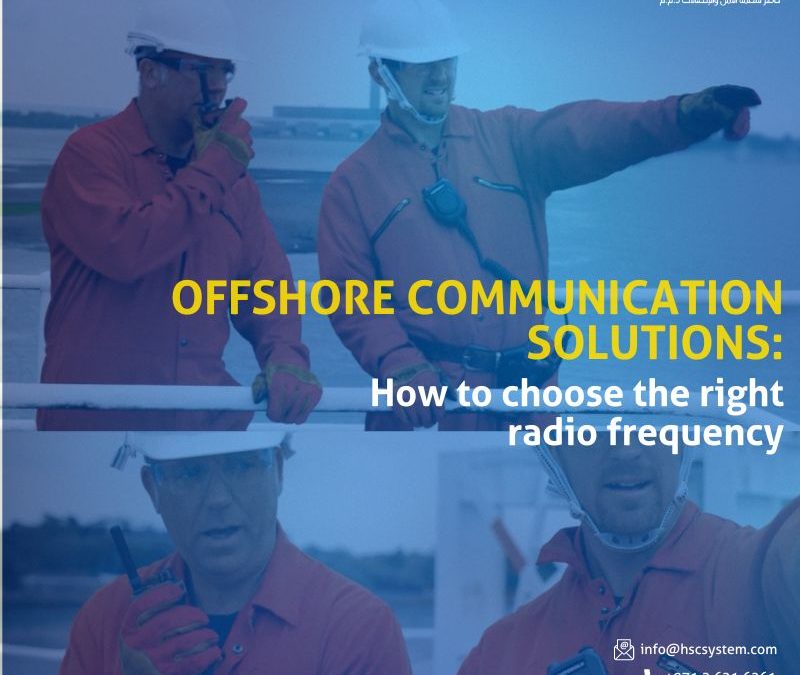How to Make your Offshore Communication to the Next Level
In this article, we’ll delve into the process of selecting the optimal radio frequency for reliable offshore communication so we can take your offshore communication to the next level.
When it comes to offshore communication solutions, selecting the appropriate radio frequency is paramount. A poorly chosen frequency can lead to ineffective communication or even complete communication breakdowns, jeopardizing the safety, productivity, and efficiency of offshore operations.
Understanding Radio Frequencies
Before we dive into the specifics of choosing a radio frequency for offshore communication, it’s important to understand what radio frequencies are and how they work. Radio frequencies are electromagnetic waves that are used to transmit information through the air.
Radio waves are measured in Hertz (Hz), which represents the number of waves that pass through a point in one second. The higher the frequency, the more waves pass through a point in one second, resulting in shorter wavelengths.
Choosing the Right Radio Frequency for Offshore Communication
When choosing the right radio frequency for your offshore communication needs, there are several factors to consider. These factors include the distance you need to transmit, the type of antenna you’re using, the environment you’re operating in, and the frequency band that’s available for use.
- Distance
The distance you need to transmit is one of the most important factors to consider when choosing the right radio frequency for offshore communication. The further you need to transmit, the lower the frequency you’ll need to use. Lower frequencies can travel further distances, but they have lower bandwidth and can be more susceptible to interference. Higher frequencies have shorter ranges but offer higher bandwidth and are less susceptible to interference. - AntennaThere are several types of antennas that can be used for offshore communication, depending on the specific needs of your radio system. Some common types of antennas used for offshore communication include:
- Omni-directional antennas: Omni-directional antennas are often used for short-range communication, such as ship-to-ship or ship-to-shore communication.
- Directional antennas: These antennas are often used for long-range communication, such as offshore oil and gas operations or deep-sea exploration.
- Yagi antennas: Yagi antennas can provide excellent performance over long distances but can be more susceptible to interference from other radio systems.
- Patch antennas: These antennas can provide good performance over short to medium distances and are often used for ship-to-shore communication.
- Helical antennas. These antennas can provide reliable performance in harsh offshore environments and are often used for ship-to-ship or ship-to-shore communication.
By selecting the right antenna, you can ensure that your radio system provides reliable and effective communication for your offshore operations.
The type of antenna you’re using is another important factor to consider when choosing the right radio frequency. The antenna you use will affect the range and performance of your radio system. Different antennas are designed for different frequencies, so it’s important to choose an antenna that’s compatible with the frequency you’ve chosen.
- Environment
The environment you’re operating in is another important factor to consider when choosing the right radio frequency. If you’re operating in a busy port or harbor, you may need to choose a frequency that’s less susceptible to interference from other radio systems. If you’re operating in a remote location, you may need to choose a frequency that can travel longer distances. - Frequency Band
The frequency band that’s available for use is another important factor to consider when choosing the right radio frequency. Different frequency bands are allocated for different uses, so it’s important to choose a frequency band that’s suitable for your needs. Some frequency bands are reserved for specific uses, such as emergency communications or navigation, so it’s important to be aware of these restrictions when choosing a frequency.
- The radio frequency used in offshore communication solutions typically depends on the specific application and location. However, some common frequency bands used in offshore communication include VHF (Very High Frequency) and UHF (Ultra High Frequency) bands.
Conclusion
Choosing the right radio frequency for your offshore communication needs is essential for safety, productivity, and efficiency. By considering factors such as distance, antenna, environment, and frequency band, you can ensure that you choose a frequency that’s reliable and effective for your specific needs.
If you want to know more information contact us at 971 2 621 626 or visit www.hscsystem.com and Connect with us on linkedin, just visit the website www.linkedin.com

